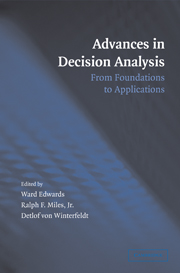Book contents
- Frontmatter
- Contents
- List of Contributors
- Preface
- 1 Introduction
- PART I HISTORY AND FOUNDATIONS OF DECISION ANALYSIS
- PART II STRUCTURING DECISION PROBLEMS
- PART III PROBABILITIES AND BAYES NETS
- PART IV UTILITIES
- PART V RISK ANALYSIS
- 15 Probabilistic Risk Analysis for Engineered Systems
- 16 The Engineering Risk-Analysis Method and Some Applications
- 17 Health Risk Analysis for Risk-Management Decision-Making
- PART VI DECISION ANALYSIS IN A BEHAVIORAL AND ORGANIZATIONAL CONTEXT
- PART VII APPLICATIONS OF DECISION ANALYSIS
- Index
- References
15 - Probabilistic Risk Analysis for Engineered Systems
Published online by Cambridge University Press: 05 June 2012
- Frontmatter
- Contents
- List of Contributors
- Preface
- 1 Introduction
- PART I HISTORY AND FOUNDATIONS OF DECISION ANALYSIS
- PART II STRUCTURING DECISION PROBLEMS
- PART III PROBABILITIES AND BAYES NETS
- PART IV UTILITIES
- PART V RISK ANALYSIS
- 15 Probabilistic Risk Analysis for Engineered Systems
- 16 The Engineering Risk-Analysis Method and Some Applications
- 17 Health Risk Analysis for Risk-Management Decision-Making
- PART VI DECISION ANALYSIS IN A BEHAVIORAL AND ORGANIZATIONAL CONTEXT
- PART VII APPLICATIONS OF DECISION ANALYSIS
- Index
- References
Summary
Probabilistic risk assessment (PRA) provides practical techniques for predicting and managing risks (i.e., frequencies and severities of adverse consequences) in many complex engineered systems. In this chapter, we survey methods for PRA and decision making in engineered systems, emphasizing progress in methods for dealing with uncertainties (e.g., via Bayesian belief networks, with dependencies among inputs expressed via copulas), communicating results effectively, and using the results to guide improved decision making by multiple parties (e.g., teams of stakeholders). For systems operating under threats from intelligent adversaries, novel methods (e.g., game-theoretic ideas) can help to identify effective risk-reduction strategies and resource allocations. The focus on methodology reflects the belief of the authors that in hard decision problems, where the risks and the best courses of action are unclear (often because of sparse, ambiguous, or conflicting data), state-of-the-art methodology may be critical to good risk management. This chapter discusses some of the most useful current methodologies, and suggests possible directions for extensions and improvements.
Overview of Risk Analysis for Engineered Systems
Application Areas
Probabilistic risk assessment (PRA) provides a body of practical techniques that can help engineers and risk managers to predict and manage risks (i.e., frequencies and severities of adverse consequences) in a variety of complex engineered systems. Examples of the types of systems to which PRA has been successfully applied include: nuclear power plants (beginning with the Reactor Safety Study (USNRC, 1975) and continuing to the present day); the space shuttle (to which risk analysis has been applied both before and especially after the Challenger disaster); dam and reservoir planning; highways and bridges; emergency planning; terminals and storage facilities for liquefied natural gas and other hazardous chemicals; and electric power generation and planning.
Information
- Type
- Chapter
- Information
- Advances in Decision AnalysisFrom Foundations to Applications, pp. 279 - 301Publisher: Cambridge University PressPrint publication year: 2007
References
Accessibility standard: Unknown
Why this information is here
This section outlines the accessibility features of this content - including support for screen readers, full keyboard navigation and high-contrast display options. This may not be relevant for you.Accessibility Information
- 12
- Cited by
